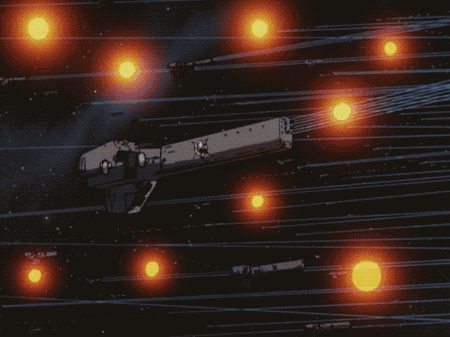
797/488. Reinhard sends Mittermeyer to kick the asses of some extremely whiny nobles, which he does with aplomb. Later, Reinhard sends Mittermeyer and Reuental together to… well, to attempt to kick the ass of Ovlesser, a significantly more threatening noble. Tensions mount among Braunschweig’s team, particularly between Merkatz and everyone else (save Schneider, of course). Reuental and Mittermeyer succeed at capturing Ovlesser, after much frustration and at great cost. Despite everyone else’s desire for revenge, the sinister Oberstein convinces Reinhard (and Reuental and Mittermeyer) to let Ovlesser go; as Oberstein predicts, Ovlesser’s comrades-in-nobility interpret his return as meaning that he betrayed them in some way, and he is unceremoniously executed as a traitor. Chalk up another win for Oberstein’s fucked up plans! Meanwhile, Mittermeyer makes moon-eyes at Reuental, and Ferner enjoys carrying out Oberstein’s plans a little too much imo.
Reuental and Mittermeyer

(From “My Conquest.”)
I promised early on that eventually, Reuental and Mittermeyer’s relationship would stand alongside Reinhard and Kircheis’s as one of LoGH’s two epic love stories. Sadly, Reuental and Mittermeyer have had very little screentime up to this point, so I haven’t had much reason to talk about them for longer than to remind you that yes, they did go on a date this episode, thank you very much. Until now! Finally, in episode 20, Reuental and Mittermeyer take center stage, which makes now the perfect time to dig into their presence on the show so far.
Synchronization
When it comes to battle, Reuental and Mittermeyer are a well-oiled machine. We’ve seen them consult with each other before and after fleet battles; we’ve also seen them work together fluidly in hand-to-hand combat, without the need to consult at all:

Above, Reuental and Mittermeyer communicate in a kind of shorthand: Rather than speaking directly about their plan, they talk around it, with the implicit assumptions not only that it’s already been decided save the details, but also that they both know what it is. And unlike the dynamic between Reinhard and Kircheis, who also have their own non-verbal methods of communication, neither Reuental nor Mittermeyer is subservient to the other: Both have an equal say and exercise their right to express that without hesitation.

(From episode 11.)
We see this dynamic play out again in episode 20, when Reinhard sends Reuental and Mittermeyer to take down the bloodthirsty High Admiral Ovlesser. When the original plan to overwhelm him with battle-axe-armed infantry fails miserably (and violently, so, so violently), Reuental and Mittermeyer decide to go in themselves as bait—which all seems perfectly normal until you realize that they never actually discussed this plan out loud.

When they do eventually succeed at trapping Ovlesser, the battle-harmony between Reuental and Mittermeyer is even further emphasized, this time with some clever camerawork:

Mittermeyer and Reuental have been acting as one all this time, but here the camera goes a step further and treats them like one physical body. Even when Reuental and Mittermeyer aren’t occupying space together on the screen, LoGH’s creators want to make sure we interpret them as two halves of a whole. This is a lot more than just a throwaway cinematic trick.
Body Language
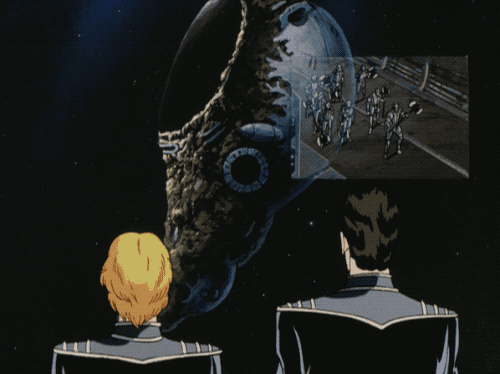
In the absence of expository flashbacks, the characterization of Reuental and Mittermeyer’s relationship is conveyed to us mainly via their (present-day) physicality. And the way they move when they’re onscreen together is unique to them, a visual representation of a type of intimacy we don’t see with the relationships between any other characters.
The gif above, in which Reuental and Mittermeyer sigh in unison, is a straightforward but striking example of how precisely their movements are choreographed to match one another. Mittermeyer leans his head slightly forward; Reuental leans his slightly back; the amount of negative space between them stays exactly the same the whole time, just shaped a little differently. Without mimicking each other’s positions, Reuental and Mittermeyer manage to give the impression of perfect balance. It’s a kind of approximate visual symmetry that’s both very expressive and very satisfying to watch—and we’ve been watching it, in fact, since “My Conquest.”
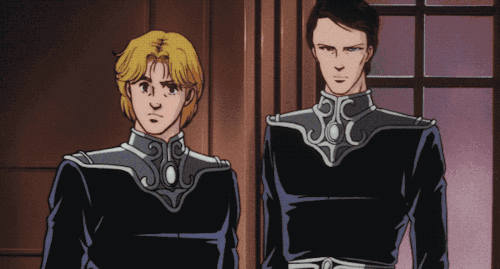
(From “My Conquest.”)

Not even the fact that Mittermeyer is several inches shorter than Reuental can get in the way of their visual balance—above, for example, Mittermeyer walks slightly ahead of Reuental, so his time in the center of the screen is longer. Below, Mittermeyer brims with energy and dynamism while Reuental is still as a statue until he expresses his restrained but emphatic agreement:

This isn’t the first time we’ve seen a couple’s dynamic encapsulated in how they move to fill the screen. In fact, the contrast with Reinhard and Kircheis’s framing helps reveal how carefully the animators worked to portray Reuental and Mittermeyer as equals:

When you combine all these elements—the give-and-take, the use of negative space, the slightly uneven but somehow perfectly balanced movement—you end up with scenes like the one below, in which Reuental and Mittermeyer discuss their aforementioned (and silently agreed upon) plan to ensnare Ovlesser. It’s a scene that is so casually well-choreographed that it is truly a wonder to behold:
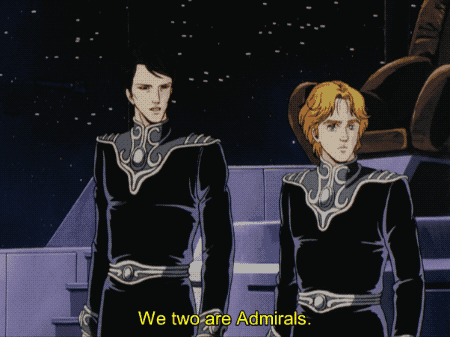
Above, Mittermeyer, who waits a beat before responding to Reuental’s movements, shifts his stance into the negative space that Reuental has just vacated, which keeps their bodies aligned. Mittermeyer puts his hands on his hips (a favorite position for him), and Reuental follows by putting his behind his back, so the space their bodies occupy is symmetrical but their postures are not. Mittermeyer waits for Reuental to put his openly gesturing hand away before putting both of his up; and through it all Mittermeyer is affectionately watching Reuental’s face while he describes their plan to someone offscreen.
At this point in LoGH, we still know next to nothing about who these two ridiculously handsome and distinguished admirals are. But if we pay attention to how their bodies interact on screen, we can begin to piece together who they are to each other. With Reuental and Mittermeyer, that’s a really good place to start.
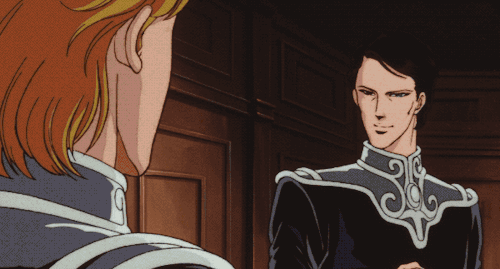
(From “My Conquest.”)
Ugh, More Character Redraws
I regret to inform you, dear readers, that the fiends behind LoGH’s cursed “remastered” character redraws are back at it again, and this time, it’s personal:

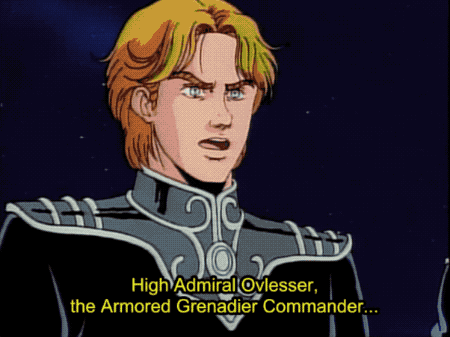
Of all the characters who suffer from redraws—and nobody is safe, NOBODY—Reuental truly has it the worst, because the changes made to his expressions venture into character assassination territory. Above, you can see a perfect example of how Reuental’s demeanor was completely altered (on left) from how he was originally animated in the LaserDisc version (right). On the LD, Reuental learns who is guarding the passage he is to infiltrate with Mittermeyer, and he is visibly concerned. In the remasters, his apprehensive frown is flipped into a smile that says: “I’m not the kind of person who would worry about all the troops under my command who are probably about to get killed!”
This is far from the last time we’ll see Reuental’s character hardened like this, and I promise I will point out EVERY SINGLE INSTANCE, because Reuental was originally drawn to be a lot warmer, gentler, and more human than the redraws would have you believe. It should go without saying that this is a pretty significant change, and one that has the potential to affect one’s interpretation of Reuental (and of Mittermeyer) a great deal—it should also go without saying that when there are big differences like the one above, I’ll be analyzing (and embedding gifs of) the original LD versions.
Stray Tidbits
- I’m honestly so impressed with the visual shorthand for “awful” that the animation team uses to describe the Imperial nobles. It basically comes down to nothing more than their hair and facial expressions, but the overall impression is that they sure are a bunch of fancy little boys.
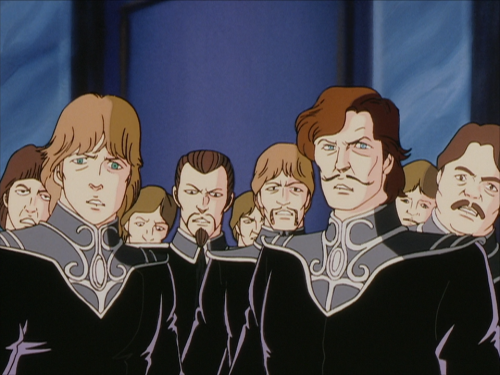

- My first impulse is that Ferner needs to calm the fuck down for two seconds, but on the other hand, I guess I’m glad he has an acceptable outlet for his weird urges?

- Besides war, drinking, and going on dates with Reuental (which usually involve drinking), Mittermeyer’s favorite hobby is roasting Bayerlein. Seriously every time Bayerlein tries to get in Mittermeyer’s good graces in some way, Mittermeyer shuts him down spectacularly. It’s incredible. I don’t know what Mittermeyer’s problem is but I’m not complaining, I mean look at that side-eye/eyeroll hybrid!

- Mittermeyer is so good at war that he gave this guy an ulcer that almost killed him. Sure, I buy it.
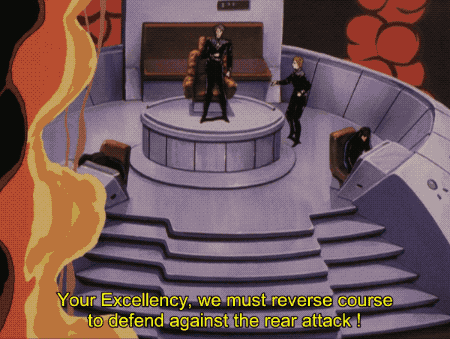
- I’ve gotten a lot of mileage out of this gif, so now I offer it to you, humble reader. Go forth and use it well.
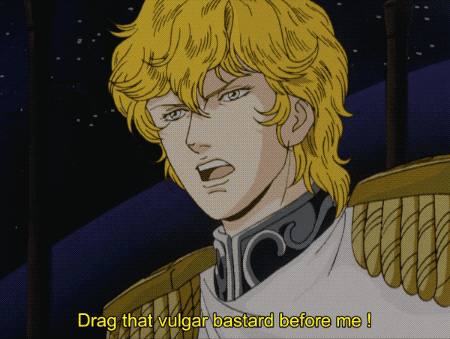
Notes
mimmixerenard liked this
legendofthedumbass reblogged this from logh-icebergs
 ywlshb liked this
ywlshb liked this dissociatingdumbass reblogged this from logh-icebergs
dissociatingdumbass liked this
regeek liked this
kdoto liked this
 gilglirthemaia liked this
gilglirthemaia liked this  themagicalandmarvelousgeek liked this
themagicalandmarvelousgeek liked this synesthesiakalaka liked this
bluegrowlmon liked this
 fleur-xael liked this
fleur-xael liked this yarnold liked this
bhishma99 liked this
irealisedidontwannaleave liked this
shining-lalah liked this
 imbricator liked this
imbricator liked this nugundams said: yessss finally some ReuMitt content I love Kirhard & all but I’m excited for you guys to get past S1 so we can focus on other characters/relationships
nugundams liked this
laureleafsage liked this
slashneggs reblogged this from logh-icebergs and added:
I am totally ready to marathon LOTGH just because of Reuental and Mittermeyer now (Though I know this ship will bring me...
bottle-it-out reblogged this from logh-icebergs
bottle-it-out liked this
dressthesavage liked this
slashneggs liked this
logh-icebergs posted this
